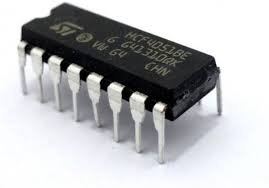IC 40106 – Hex Schmitt Trigger Inverter (Pack of 2)
18 in stock
The IC 40106 is a hex Schmitt trigger inverter, part of the 4000 series CMOS logic family. It contains six independent inverters with Schmitt trigger inputs, which provide enhanced noise immunity and signal stability. This IC is used in digital circuits for signal conditioning, waveform shaping, and improving reliability in noisy environments.
₹45.84 ₹94.40 (Incl. GST)
18 in stock
IC 40106 – Hex Schmitt Trigger Inverter (Pack of 2)
Overview
The IC 40106 is a hex Schmitt trigger inverter, part of the CMOS 4000 series of integrated circuits. It consists of six independent inverters, each with a Schmitt trigger input, meaning it provides hysteresis, or noise immunity, to the input signal. This makes the IC 40106 ideal for signal conditioning, waveform shaping, and creating stable oscillators. The Schmitt trigger inputs convert noisy or slow input transitions into sharp, clean digital signals, which are essential in a wide range of applications.
Features
- Hex Inverters with Schmitt Trigger Inputs: Six independent inverters, each with hysteresis for noise immunity.
- Wide Operating Voltage Range: Operates from 3V to 15V, suitable for various power supplies.
- Low Power Consumption: CMOS technology ensures minimal power usage.
- High Noise Immunity: Converts noisy signals into clean digital outputs.
- Standard Pin Configuration: Fits easily into existing circuit designs.
- Latch-Up-Free Operation: Enhanced reliability in noisy environments.
Pin Configuration
The IC 40106 is housed in a 14-pin Dual In-line Package (DIP), with the following pinout:
- Pin 1: Input of Inverter 1
- Pin 2: Output of Inverter 1
- Pin 3: Input of Inverter 2
- Pin 4: Output of Inverter 2
- Pin 5: Input of Inverter 3
- Pin 6: Output of Inverter 3
- Pin 7: GND (Ground)
- Pin 8: Output of Inverter 4
- Pin 9: Input of Inverter 4
- Pin 10: Output of Inverter 5
- Pin 11: Input of Inverter 5
- Pin 12: Output of Inverter 6
- Pin 13: Input of Inverter 6
- Pin 14: Vcc (Positive Supply Voltage)
Working Principle
Each inverter within the IC 40106 operates with a Schmitt trigger input, which means it has a threshold voltage that the input signal must cross to change the output state. This threshold behavior provides hysteresis, ensuring that small fluctuations in the input do not cause rapid switching in the output.
- Input: A slow or noisy analog signal is applied to the input of an inverter.
- Output: The output is a clean, sharp digital signal, either high or low, depending on whether the input is above or below the threshold voltage.
Applications
- Signal Conditioning: Converts noisy or analog signals into clean digital pulses.
- Waveform Shaping: Transforms sine, triangular, or other waveforms into square waves.
- Oscillators: Forms the basis of simple RC or crystal oscillators.
- Debouncing: Used in switch debouncing circuits to eliminate noise in mechanical switch inputs.
- Frequency Generation: Generates stable clock signals for digital circuits.
- Pulse Generators: Creates precise timing pulses for various electronic applications.
Example Circuit
- RC Oscillator: Connect an RC network to the input of an inverter in the IC 40106 to create a stable square wave oscillator.
- Debouncing Circuit: Use one inverter to debounce a mechanical switch, ensuring clean, noise-free digital transitions.
- Schmitt Trigger Oscillator: A basic circuit using an inverter and a capacitor/resistor to generate a square wave.
Advantages
- Noise Immunity: Schmitt trigger inputs provide hysteresis, making the IC ideal for noisy environments.
- Versatility: Can be used in a wide range of applications, from oscillators to waveform generators.
- Low Power Consumption: Suitable for battery-powered devices.
- Wide Operating Voltage: Compatible with different power supply configurations.
- Ease of Use: Standard pin configuration and simple design make it easy to integrate into circuits.
Conclusion
The IC 40106 is a versatile and reliable component, essential for many digital electronics applications where signal conditioning and noise immunity are required. Its six inverters with Schmitt trigger inputs allow it to clean up noisy signals, create stable oscillators, and perform waveform shaping, making it a valuable tool for both hobbyists and professionals. Whether you’re working on a simple debouncing circuit or a complex oscillator, the IC 40106 provides a robust and efficient solution.





